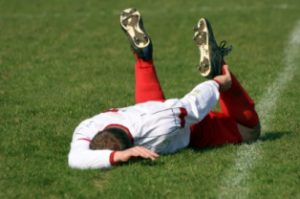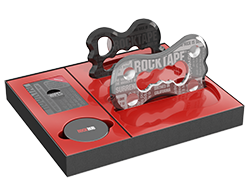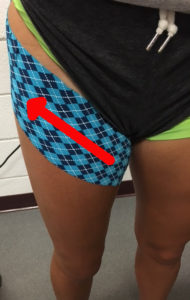by Mitch Hauschildt, MA, ATC, CSCS
Several weeks ago, I wrote about a taping technique that I was using as a variation of tweak taping to assist one of our women’s soccer players return to play after tearing her ACL. At that time, she concluded that she wanted to try to finish her season before having her ACL reconstructed. Since that time, I have had a number of inquiries into how she is doing and if she was able to make it back to playing Division I soccer without having her ACL reconstructed. So, I thought I would take this week’s post to update everyone on her progress and give an overview as to what types of interventions and tools we used in her treatment program.
The short answer to her progress is that as of now, her career is officially over. The good thing is that her career isn’t over because of her knee, it is because their season is complete and they didn’t qualify for post season play, so she is done. I am happy to report that after missing 5 games with a torn ACL, she did return to compete in the last 5 games of the season, averaging around 45 minutes per contest and scoring a goal in her 2nd game back. GPS monitoring also showed that in her final game of the season, she reached 18.9 mph during a sprint for the ball, which was the fastest top speed reached on the field that day.
Clearly she performed well, and honestly better than many people expected. How was she able to play successfully at a very high level of a competitive soccer without an ACL? First (and most importantly), she was the perfect patient for this type of rehab. I would not have recommended this option for a number of my athletes because they don’t have the mental toughness, attention to detail and motivation that were required to make a run at this task. She was willing to do whatever I asked and whenever I asked it of her.
Second, I was able to spend as much time with her as we needed. In the first few weeks following her injury, we worked twice a day, 5 days per week and once a day the other 2 days. On her two-a-day treatment sessions, we dedicated 3-4 total hours to her treatment. Many of you (both clinicians and athletes) don’t have that large amount of time to commit to this process, so I want to keep that in perspective.
Third, I have access to a lot of facilities and treatment options. We utilize interventions such as vibration training, Instrumented Soft Tissue Mobilization (IASTM) and Kinesiology Taping techniques, among others. We are able to combine those treatment options with our athletic training room, a full weight room and outdoor turf fields to get a lot of work accomplished. She was also able to make large strides thanks to our sports psychologist.
Finally, we were very specific and dialed into her therapy. We mixed manual therapies with neuromuscular education and strength and conditioning principles effectively to give her the best possible outcome. I firmly believe that we can make up for a lot of things, such as a torn ACL, with neurological education and a tireless dedication to perfection with movement quality.
I don’t want to discourage some of you who have athletes in the same situation and might not have access to all of these resources. But, I also don’t want to paint a perfectly rosy picture that this was an easy task. I learned a lot in this process and want to share our programming in hopes that it helps others in a similar situation.
Here is an overview of her return to play programming. Many of the items build on each other and if you don’t see an update from day to day or week to week, you can usually assume that we continued that part of the program and/or built on previous weeks to progress her.
- Week 1
- Day 1:
- Control Swelling
- Milking Massage
- Fluid Dynamics Taping of the entire leg (see picture)
- Control Swelling
- Down regulate Pain
- IASTM – Feathering stroke over the knee

- Improve Trunk and Core Control
- Diaphragmatic Breathing
- Positional Release Therapy on Psoas combined with PROM
- Core Engaged Bridge
- Core Engaged Leg LoweringTRX March
- Improve Lower Extremity Neuromuscular Control
- Benefit from Fluid Dynamics Taping
- IASTM – Ruffini Stroke on Quads to down regulate, Pacinian Stroke on Hamstrings/Gastroc to upregulate
- Tibial Internal Rotation Mobilizations
- Vibration Squat
- Introduce Squatting Movements
- Goblet Squat
- Introduce Hip Hinging Movements
- KB Deadlift
- IASTM – Feathering stroke over the knee
- Day 2:
- Control Swelling
- Down Regulate Pain
- Improve Trunk and Core Control
- Improve Lower Extremity Neuromuscular control
- Improve Squatting Movements
- Improve Hip Hinging Movements
- Day 3:
- Control Swelling
- Down Regulate Pain
- Improve Trunk and Core Control
- Add Pallof Press
- Improve Lower Extremity Neuromuscular control
- Introduce Single Leg Squat off box with Reactive Neuromuscular Training (RNT)
- Introduce light plyometrics
- Single Leg Jumping on the Shuttle with a light load
- Improve Squatting Movements
- Improve Hip Hinging Movements
- Conditioning
- Battling Ropes, Jump Rope interval
- Day 4:
- Improve Lower Extremity Neuromuscular Control
- IASTM
- Tweak Taping of Proximal Quad/Femur

- Extended pain taping to improve LE stability
- Improve Core and Trunk Control
- Introduce Core Mobility Series (CMS) as a warm up
- Introduce Deceleration Training
- Box Step Offs
- Drop Lunge
- Drop Lateral Lunge
- Progress Plyometrics
- Low level jumps
- Low Box Jumps – emphasizing landing
- Conditioning
- Bike
- Improve Lower Extremity Neuromuscular Control
- Day 5:
- Control Soreness
- IASTM
- PRT
- CMS
- Improve Neuromuscular Control
- Increased Single Leg Movements
- Improve Deceleration Training
- Progress Plyometrics
- Variety of jumping through various obstacles
- Heavy Strength Training Session
- Squats
- Romanian Deadlifts
- Leg Press
- Core Training
- Conditioning
- Ropes, Jump Rope circuit
- Control Soreness
- Day 6:
- Recovery Focus
- IASTM
- Foam Roll
- Ice Bath as needed
- Light Core and Trunk Motor Control Work
- Recovery Focus
- Day 7:
- Control Soreness
- IASTM
- CMS
- Conditioning
- Ropes, Jump Rope, Rip Trainer Rotate and Press Interval
- Control Soreness
- Day 1:
- Week 2
- Day 1:
- Morning Session: Movement Quality
- Corrective Exercise
- Deceleration Training
- Plyometrics
- Afternoon Session: Conditioning
- Morning Session: Movement Quality
- Day 2:
- Morning Session: Strength
- Moderate to heavy lifting session
- Afternoon Session: Deceleration and Light Plyometrics
- Introduce some rotation and lateral jumping
- Morning Session: Strength
- Day 3:
- Morning Session: Activation and Conditioning
- Aerobic Conditioning Session
- Afternoon Session: Soft Tissue Mobilization and Recovery
- IASTM and Stretch
- Morning Session: Activation and Conditioning
- Day 4:
- Morning Session: Sprint Drills
- Prepare for running and some anaerobic conditioning
- Afternoon Session: Strength
- Moderate Intensity Total Body Lift with Team
- Team is in season, so volume is low for them, but good for her
- Morning Session: Sprint Drills
- Day 5:
- Morning Session: Introduce Running
- Sprint Drills
- 6 x 40 yds at 80% Full Sprint
- Afternoon Session: Plyometrics
- Multidirectional Plyometrics
- Obstacle Course
- Morning Session: Introduce Running
- Day 6:
- Morning Session: Strength
- Total Body Lift
- Morning Session: Strength
- Day 7:
- Off
- Day 1:
- Week 3
- Day 1:
- Morning Session: Movement Quality and Speed Work
- Corrective Exercise
- 8 x 50 yds at 90% Full Sprint
- Afternoon Session: Plyometrics
- Moderate Intensity with tight lateral work
- Morning Session: Movement Quality and Speed Work
- Day 2:
- Morning Session: Introduction to lateral speed and agility
- Tight, controlled agility work
- Afternoon Session: Strength
- Lift with Team
- Morning Session: Introduction to lateral speed and agility
- Day 3:
- Morning Session: Recovery and Aerobic Conditioning
- Soft Tissue Work
- Elliptical
- Afternoon Session: Soccer Drills
- Soccer Drill work with Team
- Morning Session: Recovery and Aerobic Conditioning
- Day 4:
- Morning Session: Lateral Speed and Agility
- High Intensity, long duration lateral speed and agility session
- Afternoon Session: Soccer Drills
- Soccer Drill work with Team
- Morning Session: Lateral Speed and Agility
- Day 5:
- Morning Session: Speed Conditioning
- 10 x 110 yds on 1 minute cycles
- Afternoon Session: Strength
- Lift with Team
- Morning Session: Speed Conditioning
- Day 6:
- Morning Session: Soccer Drills
- Soccer Drill work with Team
- Morning Session: Soccer Drills
- Day 7:
- Off to watch team play
- Day 1:
- Week 4
- Day 1:
- Morning Session: Movement Quality
- Corrective Exercise
- Afternoon Session: Soccer
- Individual Workout with Coach
- Morning Session: Movement Quality
- Day 2:
- Morning Session: Light Plyometrics
- Afternoon Session: Soccer
- Full Practice with the exception of contact
- Day 3:
- Morning Session: Strength
- Lift with Team
- Afternoon Session: Soccer
- Full Practice with Team
- Morning Session: Strength
- Day 4:
- Morning Session: Movement Quality
- Corrective Exercise
- Afternoon Session: Soccer
- Full Practice with Team
- Morning Session: Movement Quality
- Day 5:
- Morning Session: Movement Quality
- Corrective Exercise
- Afternoon Session: Soccer
- Full Practice with Team
- Morning Session: Movement Quality
- Day 6:
- Morning Session: Soccer
- Full Practice with Team
- Morning Session: Soccer
- Day 7:
- Game Day
- Played 54 minutes in a 2 OT tie
- Game Day
- Day 1:
A few notes to keep in mind are that throughout the treatment process, we used a lot of IASTM with the Pacinian/Ruffini methodology that I discussed early in the treatment process. This continued to reinforce that we want the hamstrings to turn on a high rate and the quads to down regulate to minimize the anterior translation of the tibia.
I continued to “tweak tape” her proximal quad into external rotation as well as used an extended pain taping technique on her legs. Subjectively, the patient was a lot more confident with the tape on and stated that she felt a lot more lower extremity control.
Overall, she has been a very fun patient and my work with her is just beginning as she will be having her ACL reconstructed in the next few weeks. Again, she is a great candidate for this type of aggressive rehab, but it does show that even with a torn ACL, some athletes can continue to compete at a very high level.


Leave a Reply